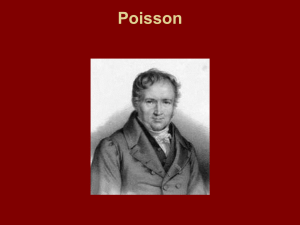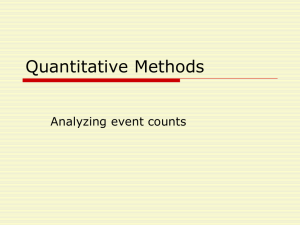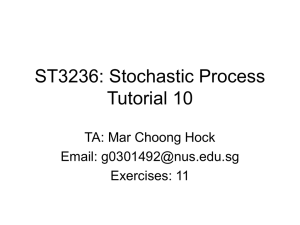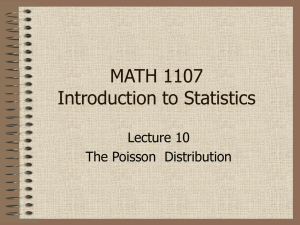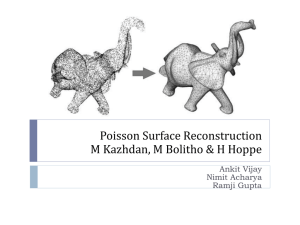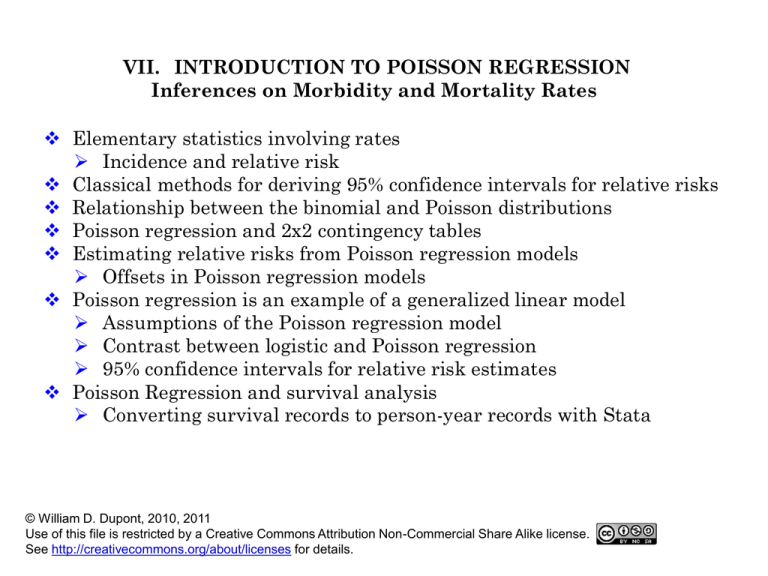
VII. INTRODUCTION TO POISSON REGRESSION
Inferences on Morbidity and Mortality Rates
Elementary statistics involving rates
Incidence and relative risk
Classical methods for deriving 95% confidence intervals for relative risks
Relationship between the binomial and Poisson distributions
Poisson regression and 2x2 contingency tables
Estimating relative risks from Poisson regression models
Offsets in Poisson regression models
Poisson regression is an example of a generalized linear model
Assumptions of the Poisson regression model
Contrast between logistic and Poisson regression
95% confidence intervals for relative risk estimates
Poisson Regression and survival analysis
Converting survival records to person-year records with Stata
© William D. Dupont, 2010, 2011
Use of this file is restricted by a Creative Commons Attribution Non-Commercial Share Alike license.
See http://creativecommons.org/about/licenses for details.
1.
Elementary Statistics Involving Rates
The Framingham Heart Study data set contains information on 4,699
subjects with 103,710 patient-years of follow-up. We can extract the
following table from this data.
Men
Cases of Coronary
Heart Disease
d1 =
823
Person-years of
Follow-up
n1 =
42,259
Women
d0 =
Total
650
1,473
n 0 = 61,451
103,710
a) Incidence
The incidence of CHD in men is
d1 / n1
= 823/42,259
= 0.01948.
The incidence of CHD in women is
d0 / n0
= 650/61,451
= 0.01058
b) Relative Risk
The relative risk of CHD in men compared to women is estimated by
Rˆ ( d 1 / n1 ) /( d 0 / n 0 ) = 0.01948/0.01058 = 1.841.
c) 95% confidence interval for a relative risk
If di is small compared to ni (i = 0 or 1) then
The variance of (log R ) is approximated by
s2
log( Rˆ )
{7.1}
1
1
d1 d 0
1
1
823 650 = 0.002754
Hence a 95% confidence interval for R is
Rˆ exp ± z 0 .0 2 5 s log( Rˆ )
(
)
= [ 1.841 exp(-1.96 0.002754 ), 1.841 exp(0.1029)]
= [1.66, 2.04]
In Stata these calculations are done as follows:
{7.2}
.
.
.
.
.
.
* 8.2.Framingham.log
*
* Estimate the crude (unadjusted) relative risk of
* coronary heart disease in men compared to women using
* person-year data from the Framingham Heart Study (Levy 1999).
*
. * Statistics > Epidemiology... > Tables... > Incidence-rate ratio calculator
. iri 823 650 42259 61451
{1}
|
Exposed
Unexposed |
Total
-----------------+------------------------+-----------Cases |
823
650 |
1473
Person-time |
42259
61451 |
103710
-----------------+------------------------+-----------|
|
Incidence rate | .0194751
.0105775 |
.0142031
|
|
|
Point estimate
|
[95% Conf. Interval]
|------------------------+-----------------------Inc. rate diff. |
.0088976
|
.0073383
.010457
Inc. rate ratio |
1.84118
|
1.659204
2.043774
Attr. frac. ex. |
.45687
|
.3973015
.510709
Attr. frac. pop |
.2552641
|
+------------------------------------------------(midp)
Pr(k>=823) =
0.0000
(midp) 2*Pr(k>=823) =
0.0000
(exact)
(exact)
(exact)
(exact)
{1} The ir command is used for incidence rate data.
Shown here is the immediate version of this command, called iri,
which analyses the four data values given in the command line.
These data are the number exposed and unexposed cases together
with the person-years of follow of exposed and unexposed subjects.
.
.
.
.
.
*
* The equivalent ir command is illustrated below.
*
use 8.2.Framingham.dta, clear
* Data > Describe data > List data
. list
+------------------------+
| male
chd
per_yrs |
|------------------------|
1. | Women
650
61451 |
2. |
Men
823
42259 |
+------------------------+
. * Statistics > Epidemiology... > Tables ... > Incidence-rate ratio
. ir chd male per_yrs
{2}
| Male
|
|
Exposed
Unexposed |
Total
-----------------+------------------------+-----------CHD patients |
823
650 |
1473
P-yrs follow-up |
42259
61451 |
103710
-----------------+------------------------+-----------|
|
Incidence rate | .0194751
.0105775 |
.0142031
|
|
|
Point estimate
|
[95% Conf. Interval]
|------------------------+-----------------------Inc. rate diff. |
.0088976
|
.0073383
.010457
Inc. rate ratio |
1.84118
|
1.659204
2.043774 (exact)
Attr. frac. ex. |
.45687
|
.3973015
.510709 (exact)
Attr. frac. pop |
.2552641
|
+------------------------------------------------(midp)
Pr(k>=823) =
0.0000 (exact)
(midp) 2*Pr(k>=823) =
0.0000 (exact)
{2} Here is the conventional version of this command. Person-years of
follow-up may be distributed over multiple records. If there is one
record per subject then
per_yrs gives each subject’s years of follow-up;
chd = 1 if the subject had CHD, 0 otherwise; and
male = 1 for men, 0 for women.
We next introduce Poisson regression which is used for
analyzing rates.
Poisson regression is used when the original data available to us is
expressed as events per person-years of observation.
Poisson regression is also useful for analyzing data from large
cohorts when the proportional hazards assumption is false. In this
situation Poisson regression is quicker and easier to use than hazard
regression with time-dependent covariates.
2.
The Binomial and Poisson Distribution
Let
n
be the number of people at risk of death
d
be the number of deaths
be the probability that any patient dies.
Then d has a binomial distribution with parameters n and ,
mean
n, and
variance
n(1-).
Pr[d deaths]
=
n!
(1 )
d
(n d )!d !
(nd )
{7.3}
Poisson (1781–1849) showed that when n is large and is small the
distribution of d is closely approximated by the Poisson distribution,
whose mean and variance both equal n = .
Pr[d deaths] =
e
( )
d
{7.4}
d!
Although it is not obvious from these formulas, the convergence of the
binomial distribution to the Poisson is quite rapid.
B in o m ia l a n d P o is s o n D is trib u tio n s
0 .2 5
T h e e x p e c te d n u m b e r
o f d e a th s in e a c h
d is trib u tio n is 5
P ro b a b ility
0 .2
0 .1 5
B in o m ia l: n = 1 0
B in o m ia l: n = 2 0
B in o m ia l: n = 5 0
0 .1
P o is s o n
0 .0 5
0
0
1
2
3
4
5
6
7
8
N u m b e r o f D e a th s
9
10
11
12
3.
Poisson Regression and the 2x2 Contingency Table
a) True and estimated death rates and relative risks
Consider a 2x2 contingency table
Died
Exposed
Yes
No
Yes
d1
d0
No
n1-d1
n0-d0
n1
n0
Total
Let
i be the true death rate in people who are (i = 1) or are
not (i = 0) exposed.
Died
Exposed
Yes
No
Yes
d1
d0
No
n1-d1
n0-d0
n1
n0
Total
Let
i
be the true death rate in people who are (i = 1) or are
not (i = 0) exposed.
Then
R 1 / 0
is the relative risk of death associated with exposure
and 1 R 0 ,
i d i / ni is the estimated death rate in people who are (i=1)
or are not (i=0) exposed, and
R 1 / 0 is the estimated relative risk of death associated
with exposure.
The expected number of deaths in group i is E(di) = nii.
For any constant k and statistic d, E(kd) = kE(d)
Now
0 E [ ˆ0 ] E [ d 0 / n 0 ] E [ d 0 ] / n 0
log[ 0 ] log[ E [ d 0 ]] log[ n 0 ]
, and
log[ 1 ] log[ E [ d 1 ]] log[ n1 ]
But
log [ 1 ] log[ R ] log[ 0 ]
Hence
log [ E [ d 0 ]] log[ n 0 ] log[ 0 ]
log [ E [ d 1 ]] log[ n1 ] log[ 0 ] log[ R ]
Let
= log [ 0 ] ,
= log[ R ] ,
x 0 = 0, and x 1 = 1.
Then
log[E[di]] = log[ni] + + xi for i = 0 or 1,
{7.5}
where di has a Poisson distribution whose mean and variance are
estimated by di.
This is the simplest of all possible Poisson regression models.
b) Estimating relative risks from the model coefficients
Our primary interest is in . Given an estimate of
then R e
c) Nuisance parameters
is called a nuisance parameter. This is one that is required by
the model but is not used to calculate interesting statistics
d) Offsets
log (ni) is a known quantity that must be included in the model. It is
called an offset.
4.
Poisson Regression and Generalized Linear Models
Poisson regression is another example of a generalized linear
model. The random component, linear predictor and link function
for Poisson regression are as follows.
a) The random component
di is the random component of the model. In Poisson
regression, di has a Poisson distribution with mean E(di).
b) The linear predictor
log(ni) + + xi is called the linear predictor.
c) Link function
E(di) is related to the linear predictor through a logarithmic link
function.
5.
Contrast Between Simple Poisson Logistic and Linear
Regression
The models:
Linear
E ( y i ) x i
for i = 1, 2, …, n.
Logistic
logit(E(di/mi)) = + xi for i = 0 or 1,
Poisson
log(E(di)) = log(ni) + + xi for i = 0 or 1,
Linear Regression –
In linear regression the random component is yi , which has a
normal distribution with standard deviation . The linear predictor
is x i and the link function is the identity function I(x) = x.
n must be fairly large since we must estimate before we can estimate
or .
Logistic Regression –
In logistic regression we observe di events in mi trials. The random
component is di, which has a binomial distribution. The linear
predictor is x i . The model has a logit link function.
Poisson Regression –
In Poisson regression we observe di events in ni trials. The random
component is di, which has a Poisson distribution. The linear
predictor is log(ni) + x i . The model has a logarithmic link
function.
In Poisson and logistic regression examples i has only 2 values. It is
possible to estimate from these equations since we have reasonable
estimates of the mean and variance of di for both of these models.
Poisson regression models generalize in the usual way. For example,
suppose
x i = i for i = 1 to 3 denotes three levels of a risk factor. Then a simple
Poisson regression model would be
{7.6}
log(E(di)) = log(ni) + + z 2 i b 2 + z 3 i b 3
where
di
is the number of deaths observed in n i person-years of follow-up
in group i,
ì1:i = 2
z 2i = í
î 0 : oth erw ise
and
ì1:i = 3
z3i = í
î 0 : oth erw ise
.
Subtracting lo g ( n i ) from both sides of equation {7.6} gives
log ( E (d i ) / n i ) = log ( E (d i / n i ) ) = log ( l
i
)
= a + z 2 ib 2 + z 3 ib 3
{7.7}
where l i is the true death rate for patients with risk level i.
log ( E (d i ) / n i ) = log ( E (d i / n i ) ) = log ( l
i
)
= a + z 2 ib 2 + z 3 ib 3
{7.7}
When i =2 {7.7} reduces to
log ( l
2
)=a
+ b2
{7.8}
When i =1 {7.7} reduces to
log ( l
1
)=a
{7.9}
Subtracting {7.9} from {7.8} gives
log ( l
2
/l
1
) = b2
Hence b 2 equals the log relative risk of patients in group 2 relative to
group 1.
Similarly, b 3 equals the log relative risk of patients in group 3
relative to group 1.
6.
Analyzing a 2x2 Contingency Table with Stata
a) Example: Gender and Coronary Heart Disease
.
.
.
.
.
.
* 8.7.Framingham.log
*
* Simple Poisson regression analysis of the effect of gender on
* Coronary heart disease in the Framingham Heart Study
*
use
2.20.Framingham.dta, clear
. gen male = sex==1
. gen per_yrs = followup/365.25
. * Statistics > Summaries, ... > Tables > Table of summary statistics (table)
. table male, contents(sum chdfate sum per_yrs)
{1}
-------------------------------------male | sum(chdfate) sum(per_yrs)
----------+--------------------------0 |
650
61451.17
1 |
823
42258.92
--------------------------------------
{1}
Tabulate the sum of chdfate and per_yrs by gender. Recall that
2.20.Framingham.dta contains one record per patient, with
followup giving the number of days of follow-up for each patient.
. * Statistics > Generalized linear models > Generalized linear models (GLM)
. glm chdfate male , family(poisson) link(log) lnoffset(per_yrs)
{2}
Iteration
Iteration
Iteration
Iteration
0:
1:
2:
3:
log
log
log
log
likelihood
likelihood
likelihood
likelihood
= -4240.3694
= -3906.885
= -3906.5506
= -3906.5505
Generalized linear models
Optimization
: ML
Deviance
Pearson
=
=
4867.101078
12820.44155
No. of obs
Residual df
Scale parameter
(1/df) Deviance
(1/df) Pearson
Variance function: V(u) = u
Link function
: g(u) = ln(u)
[Poisson]
[Log]
Log likelihood
AIC
BIC
= -3906.550539
=
=
=
=
=
4699
4697
1
1.036215
2.729496
= 1.663567
= -34846.53
-----------------------------------------------------------------------------|
OIM
chdfate |
Coef.
Std. Err.
z
P>|z|
[95% Conf. Interval]
-------------+---------------------------------------------------------------male |
.6104111
.0524741
11.63
0.000
.5075638
.7132584
_cons | -4.549026
.0392232 -115.98
0.000
-4.625902
-4.47215
per_yrs | (exposure)
------------------------------------------------------------------------------
{2} Regress chdfate against male. The options family(poisson) and
link(log) specify that Poisson regression is to be used.
lnoffset(per_yrs) specifies that the logarithm of per_yrs is to be
used as an offset. In short, this statement specifies model
log[E[chd]] = log[per_yrs] + + male
The exposure and lnoffset
options are identical. They
both enter the logarithm of
per_yrs into the model as an
offset.
. *Statistics > Postestimation > Linear combinations of estimates
. lincom male,irr
{3}
( 1) [chd]male = 0.0
-----------------------------------------------------------------------------chd |
IRR
Std. Err.
z
P>|z|
[95% Conf. Interval]
---------+-------------------------------------------------------------------(1) |
1.832227
.0961444
11.54
0.000
1.653154
2.030698
--------------------------------------------------------------------------------------------------------------------------------------------
{3} The irr option has the same effect as the or option. That is, it
calculates e . The only difference is that this statistic is labeled
“IRR” rather than “Odds Ratio”. IRR stands for incidence rate
ratio, which is a synonym for relative risk. The estimate of is
0.6055324. Hence the relative risk of CHD for men compared to
women is e = exp(0.6055324) = 1.832227.
N.B. The or option of the lincom command really means
“calculate e ” rather than “calculate an odds ratio” The label
odds ratio in the output would be incorrect, since in Poisson
regression e estimates a relative risk rather than an odds
ratio.
. * Statistics > Epidemiology... > Tables... > Incidence-rate ratio calculator
. iri 823 650 42259 61451
|
Exposed
Unexposed |
Total
-----------------+------------------------+-----------Cases |
823
650 |
1473
Person-time |
42259
61451 |
103710
-----------------+------------------------+-----------|
|
Incidence rate | .0194751
.0105775 |
.0142031
|
|
|
Point estimate
|
[95% Conf. Interval]
|------------------------+-----------------------Inc. rate diff. |
.0088976
|
.0073383
.010457
Inc. rate ratio |
1.84118
|
1.659204
2.043774 (exact)
Attr. frac. ex. |
.45687
|
.3973015
.510709 (exact)
Attr. frac. pop |
.2552641
|
+------------------------------------------------(midp)
Pr(k>=823) =
0.0000 (exact)
(midp) 2*Pr(k>=823) =
0.0000 (exact)
-----------------------------------------------------------------------------|
OIM
chdfate |
Coef.
Std. Err.
z
P>|z|
[95% Conf. Interval]
-------------+---------------------------------------------------------------male |
.6104111
.0524741
11.63
0.000
.5075638
.7132584
_cons | -4.549026
.0392232 -115.98
0.000
-4.625902
-4.47215
per_yrs | (exposure)
------------------------------------------------------------------------------
c) 95% confidence intervals for relative risk estimates
has an asymptotically normal distribution which allows us to
estimate the 95% CI for to be
.6104111 + 1.96x0.05247 = (0.5075, 0.7132).
The 95% CI for the relative risk R = 1.832 is
(exp(0.5075), exp(0.7132)) = (1.661, 2.041).
d) Comparison of classical and Poisson risk estimates
The classical and Poisson relative risk estimates are in exact
agreement.
The classical and Poisson 95% confidence intervals for this relative
risk agree to three significant figures.
. lincom male,irr
( 1)
[chdfate]male = 0
-----------------------------------------------------------------------------chdfate |
IRR
Std. Err.
z
P>|z|
[95% Conf. Interval]
-------------+---------------------------------------------------------------(1) |
1.841188
.0966146
11.63
0.000
1.661239
2.04063
------------------------------------------------------------------------------
Testing the null hypothesis that R = 1 is equivalent to testing the null
hypothesis that = 0.
The P value associated with this test is < 0.0005.
7.
Assumptions needed for Poisson Regression
The distribution of di will be well approximated by a Poisson
distribution if the following is true
a) Low death rates
The proportion of patients who die in each risk group should
be small.
b) Independent events
Deaths in different patients are independent events.
The denominators of rates used in Poisson regressions is often
patient-years rather than patients. Strictly speaking, deaths
used in these rates are not independent since we can only die
once. However, the independence assumption is not badly
violated as long as the number of patients is large relative to
the maximum number of years of follow-up per patient, and di
is small.
8.
Poisson Regression and Survival Analysis
For large data sets Poisson regression is much faster than hazard
regression analysis with time dependent covariates. If we have reason
to believe that the proportional hazards assumption is false, it makes
sense to do our exploratory analyses using Poisson regression. Before
we can do this we must first convert the data from survival format to
person-year format.
a) Recoding data on patients as patient-year data
Consider the following example:
Patient
ID
Entry
Age
Exit
Age
Treatment
Fate
A
B
C
D
E
1
3
3
2
1
4
5
6
3
3
1
1
2
2
2
Alive
Dead
Alive
Dead
Dead
This data can be represented graphically as follows:
T re a tm e n t 1
6
5
B
Age
4
3
D
0
1
0
1
1
1
0
A
2
0
1
0
2
0
3
2
1
0
2
0
1
0
1
0
0
0
D e a th s
0
T re a tm e n t 1
T re a tm e n t 2
1
D e a th s
P e rs o n Y e a rs o f
F o llo w -u p
C
E
2
P e rs o n Y e a rs o f
F o llo w -u p
T re a tm e n t 2
D ead
A liv e
3
4
1
2
Y e a rs o f F o llo w -u p
We need to convert the 5 patient records into 11
records of patient-years of follow-up.
9.
Converting Survival Records to Person-Years of
Follow-up.
The following program may be used as a template to convert
survival records on individual patients into records giving personyears of follow-up.
.
.
.
.
.
.
.
.
.
.
.
.
.
.
.
* 8.8.2.Survival_to_Person-Years.log
*
*
Convert survival data to person-year data.
*
The survival data set must have the following
*
variables
*
id
= patient id
*
age_in = age at start of follow-up
*
age_out = age at end of follow-up
*
fate
= fate at exit: censored = 0, dead = 1
*
treat
= treatment variable.
*
*
The person-year data set created below will
*
contain one record per unique combination of
*
treatment and age.
*
.
.
.
.
.
.
.
.
.
.
.
.
.
*
Variables in the person-year data set that must not
*
be in the original survival data set are
*
age_now = an age of people in the cohort
*
pt_yrs = number of patient-years of observations
*
of people receiving therapy treat who
*
are age_now years old.
*
deaths = number of events (fate=1) occurring in
*
pt_yrs years of follow-up for this
*
group of patients.
*
use C:\WDDtext\8.8.2.Survival.dta, clear
* Data > Describe data > List data
list
1.
2.
3.
4.
5.
id
age_in
age_out
treat
fate
A
B
C
D
E
1
3
3
2
1
4
5
6
3
3
1
1
2
2
2
0
1
0
1
1
. generate exit = age_out + 1
{1}
{1} A patient who is age_out years old at his end of follow-up
will be in his age_out plus 1st year of life at that time. We
define exit to be the patient’s year of life at the end of followup.
. * Statistics > Survival... > Setup... > Declare data to be survival...
. stset exit, id(id) enter(time age_in) failure(fate)
id:
failure event:
obs. time interval:
enter on or after:
exit on or before:
id
fate != 0 & fate < .
(exit[_n-1], exit]
time age_in
failure
-----------------------------------------------------------------------------5 total obs.
0 exclusions
-----------------------------------------------------------------------------5 obs. remaining, representing
5 subjects
3 failures in single failure-per-subject data
13.5 total analysis time at risk, at risk from t =
0
earliest observed entry t =
1
last observed exit t =
6.5
. * Statistics > Survival... > Setup... > Split time-span records
. stsplit age_now, at(0(1)6)
(11 observations (episodes) created)
{2} This command, in combination with the preceding stset
command expands the data set so that there is one record
for each patient-year of follow-up. The effects of this
command are illustrated by the following list command. See
also Handout 6, pages 60 – 61.
{2}
stset exit, id(id) enter(time age_in) failure(fate)
stsplit age_now, at(0(1)6)
. * Data > Describe data > List data
. list id age_in age_out treat fate exit age_now
1.
2.
3.
4.
5.
6.
7.
8.
9.
10.
11.
12.
13.
14.
15.
16.
+-------------------------------------------------------+
| id
age_in
age_out
treat
fate
exit
age_now |
|-------------------------------------------------------|
| A
1
4
1
.
2
1 |
| A
1
4
1
.
3
2 |
| A
1
4
1
.
4
3 |
| A
1
4
1
0
5
4 |
| B
3
5
1
.
4
3 |
|-------------------------------------------------------|
| B
3
5
1
.
5
4 |
| B
3
5
1
1
6
5 |
| C
3
6
2
.
4
3 |
| C
3
6
2
.
5
4 |
| C
3
6
2
.
6
5 |
|-------------------------------------------------------|
| C
3
6
2
0
7
6 |
| D
2
3
2
.
3
2 |
| D
2
3
2
1
4
3 |
| E
1
3
2
.
2
1 |
| E
1
3
2
.
3
2 |
|-------------------------------------------------------|
| E
1
3
2
1
4
3 |
+-------------------------------------------------------+
{3,4}
{3} There is now one record for each year of life that each
patient had complete or partial follow-up. age_now equals
age_in in each patient’s first record and is incremented
sequentially in subsequent records. It equals age_out at the
last record.
{4} fate is the patient’s true fate in his last record and is missing
for other records. stsplit divides the observed follow-up into
one year epochs with one record per epoch. Each epoch
starts at age_now and ends at exit; fate gives the patient’s
fate at the end of the epoch.
. sort treat age_now
. * Data > Create... > Other variable-trans... > Make dataset of means...
. collapse (count) pt_yrs=age_in (sum) deaths=fate, by(treat age_now)
{5}
{5} This statement collapses all records with identical values of treat
and age_now into a single record. pt_yrs is set equal to the number
of records collapsed. (More precisely, it is the count of collapsed
records with non-missing values of age_in.)
deaths is set equal to the number of deaths (the sum of non-missing
values of fate over these records). All variables are deleted from
memory except treat age_now pt_yrs and deaths.
. * Data > Describe data > List data
. list treat age_now pt_yrs deaths
1.
2.
3.
4.
5.
6.
7.
8.
9.
10.
11.
+-----------------------------------+
| treat
age_now
pt_yrs
deaths |
|-----------------------------------|
|
1
1
1
0 |
|
1
2
1
0 |
|
1
3
2
0 |
|
1
4
2
0 |
|
1
5
1
1 |
|-----------------------------------|
|
2
1
1
0 |
|
2
2
2
0 |
|
2
3
3
2 |
|
2
4
1
0 |
|
2
5
1
0 |
|-----------------------------------|
|
2
6
1
0 |
+-----------------------------------+
. save 8.8.2.Person-Years.dta, replace
file 8.8.2.Person-Years.dta saved
T re a tm e n t 1
6
5
B
Age
4
3
D
0
1
0
1
1
1
0
A
2
0
1
0
2
0
3
2
1
0
2
0
1
0
1
0
0
0
D e a th s
0
T re a tm e n t 1
T re a tm e n t 2
1
D e a th s
P e rs o n Y e a rs o f
F o llo w -u p
C
E
2
P e rs o n Y e a rs o f
F o llo w -u p
T re a tm e n t 2
D ead
A liv e
3
4
1
2
Y e a rs o f F o llo w -u p
N.B.
a)
If you are working on a large data set with many covariates you can
reduce the computing time by only keeping the covariates that you
will need in your model(s) before you start to convert to patientyear data.
b)
It is a good idea to check that you have not changed the number of
deaths or number of years of follow-up in your program. See the
8.9.Framingham.log file in the next section for an example of how
this can be done.
10.
Converting the Framingham Survival Data to Persontime Data
The following log file shows how the Framingham Heart Study survival
data set may be converted to a person-time data set that is suitable for
Poisson regression analysis.
.
.
.
.
.
.
.
.
.
.
{2}
* 8.9.Framingham.log
*
use C:\WDDtext\2.20.Framingham.dta, clear
*
* Convert bmi, scl and dbp into categorical variables
* that subdivide the data set into quartiles for each
* of these variables.
*
* Statistics > Summaries... > Summary and ... > Centiles with CIs
centile bmi dbp scl, centile(25,50,75)
{2}
In the next chapter we will consider body mass index, serum
cholesterol, and diastolic blood pressure as confounding
variables in our analyses. We convert these data into categorical
variables grouped by quartiles. This centile statement gives the 25th,
50th, and 75th quartile for bmi, dbp and scl. These are then used as
arguments in the recode function to define categorical variables
bmi_gr, dbp_gr and scl_gr.
-- Binom. Interp. -Variable | Obs Percentile
Centile
[95% Conf. Interval]
---------+----------------------------------------------------------bmi | 4690
25
22.8
22.7
23
|
50
25.2
25.1
25.36161
|
75
28
27.9
28.1
dbp | 4699
25
74
74
74
|
50
80
80
82
|
75
90
90
90
scl | 4666
25
197
196
199
|
50
225
222
225
|
75
255
252
256
. generate bmi_gr = recode(bmi, 22.8, 25.2, 28, 29)
(9 missing values generated)
. generate dbp_gr = recode(dbp, 74,80,90,91)
. generate scl_gr = recode(scl, 197,225,255,256)
(33 missing values generated)
. *
. * Calculate years of follow-up for each patient.
. * Round to nearest year for censored patients.
. * Round up to next year when patients exit with CHD
. *
. generate years=int(followup/365.25)+1 if chdfate
(3226 missing values generated)
. replace years=round(followup/365.25, 1) if ~chdfate
(3226 real changes made)
{3}
{4}
{3} The last follow-up interval for most patients is a fraction of a year.
If the patient’s follow-up was terminated because of a CHD event,
we include the patient’s entire last year as part of her follow-up.
The int function facilitates this by truncating follow-up in years to
the largest whole integer less than than followup/365.25. We then
add 1 to this number to include the entire last year of follow-up.
{4} If the patient is censored at the end of follow-up we round
this number to the nearest integer using the round function.
round(x,1) rounds x to the nearest integer.
. * Statistics > Summaries... > Tables > Table of summary statistics (table).
. table sex dbp_gr, contents(sum years) row col
{5}
----------+--------------------------------------|
dbp_gr
Sex |
74
80
90
91
Total
----------+--------------------------------------Men | 10663
10405
12795
8825
42688
Women | 21176
14680
15348
10569
61773
|
Total | 31839
25085
28143
19394 104461
----------+---------------------------------------
{6}
{5} So far, we haven’t added any records or modified any of the original
variables. Before doing this it is a good idea to tabulate the number of
person-years of follow-up and CHD events in the data set. At the end of
the transformation we can recalculate these tables to ensure that we have
not lost or added any spurious years of follow-up or CHD events.
The next two tables show these data cross tabulated by sex and dbp_gr. The
contents(sum years) option causes years to be summed over every unique
combination of values of sex and dbp_gr and displayed in the table.
{6}
For example, the sum of the years variable for men with dbp_gr = 90 is
12,795. This means that there are 12,795 person-years of follow-up for men
with baseline diastolic blood pressures between 80 and 90.
. * Statistics > Summaries... > Tables > Table of summary statistics (table).
. table sex dbp_gr, contents(sum chdfate) row col
{7}
----------+---------------------------------|
dbp_gr
Sex |
74
80
90
91 Total
----------+---------------------------------Men |
161
194
222
246
823
Women |
128
136
182
204
650
|
Total |
289
330
404
450
1473
----------+----------------------------------
{7} This table shows the corresponding number of CHD events.
. generate age_in = age
. generate exit = age + years
. summarize age_in exit
Variable |
Obs
Mean
Std. Dev.
Min
Max
-------------+-------------------------------------------------------age_in |
4699
46.04107
8.504363
30
68
exit |
4699
68.27155
10.09031
36
94
.
.
.
.
.
.
*
* Transform data set so that there is one record per patient-year of
* follow-up. Define age_now to be the patient's age in each record
*
* Statistics > Survival... > Setup... > Declare data to be survival...
stset exit, id(id) enter(time age_in) failure(chdfate)
id:
failure event:
obs. time interval:
enter on or after:
exit on or before:
id
chdfate != 0 & chdfate < .
(exit[_n-1], exit]
time age_in
failure
{Output omitted}
. * Statistics > Survival... > Setup... > Split time-span records
. stsplit age_now, at(30(1)94)
(99762 observations (episodes) created)
. * Data > Describe data > List data
. list id age_in years exit age_now in 278/282
278.
279.
280.
281.
282.
{8}
+----------------------------------------+
|
id
age_in
years
exit
age_now |
|----------------------------------------|
| 4075
59
3
62
61 |
| 4182
41
3
42
41 |
| 4182
41
3
43
42 |
| 4182
41
3
44
43 |
| 1730
46
3
47
46 |
+----------------------------------------+
{8} The expansion of the data set by the stset and stsplit
commands, and the definitions of age_now, and exit are done in
the same way as in 8.8.2.Survival_to_Person-Years.log. This list
command shows the effects of these transformations. Note that
patient 4182 entered the study at age 41 and exits at age 43 in
his 44th year of life. The expanded data set contains one record
for each of these years.
. generate age_gr = recode(age_now, 45,50,55,60,65,70,75,80,81)
{9}
. label define age 45 "<= 45" 50 "45-50" 55 "50-55" 60 "55-60" 65 ///
>
"60-65" 70 "65-70" 75 "70-75" 80 "75-80" 81 "> 80"
. label values age_gr age
. sort sex bmi_gr scl_gr dbp_gr age_gr
.
.
.
.
*
*
*
*
.
.
>
.
.
>
* Data > Create... > Other variable-trans... > Make dataset of means...
collapse (count) pt_yrs=age_in (sum) chd_cnt=chdfate
{10}
, by(sex bmi_gr scl_gr dbp_gr age_gr)
* Data > Describe data > List data
list sex bmi_gr scl_gr dbp_gr age_gr pt_yrs chd_cnt in 310/315
, nodisplay
310.
311.
312.
313.
314.
315.
Combine records with identical values of
sex bmi_gr scl_gr dbp_gr and age_gr.
+------------------------------------------------------------+
| sex
bmi_gr
scl_gr
dbp_gr
age_gr
pt_yrs
chd_cnt |
|------------------------------------------------------------|
| Men
28
197
90
45-50
124
0 |
| Men
28
197
90
50-55
150
1 |
| Men
28
197
90
55-60
158
2 |
| Men
28
197
90
60-65
161
4 |
| Men
28
197
90
65-70
100
2 |
|------------------------------------------------------------|
| Men
28
197
90
70-75
55
1 |
+------------------------------------------------------------+
{11}
{9} Recode age_now into 5-year age groups.
{10} Collapse records with identical values of sex, bmi_gr, scl_gr, dbp_gr
and age_gr. pt_yrs records the number of patient-years of followup associated with each record while chd_cnt records the
corresponding number of CHD events.
{11} For example, the subsequent listing shows that there were 161
patient-years of follow-up in men
aged 60 to 65 with
body mass indexes between 25.2 and 28,
serum cholesterols less than or equal to 197, and
diastolic blood pressures between 80 and 90 on their baseline
exams.
Four CHD events occurred in these patients during these years of
follow-up.
. * Statistics > Summaries... > Tables > Table of summary statistics (table).
. table sex dbp_gr, contents(sum pt_yrs) row col
{12}
----------+--------------------------------------|
dbp_gr
Sex |
74
80
90
91
Total
----------+--------------------------------------Men | 10663
10405
12795
8825
42688
Women | 21176
14680
15348
10569
61773
|
Total | 31839
25085
28143
19394 104461
----------+--------------------------------------. table sex dbp_gr, contents(sum chd_cnt) row col
----------+---------------------------------|
dbp_gr
Sex |
74
80
90
91 Total
----------+---------------------------------Men |
161
194
222
246
823
Women |
128
136
182
204
650
|
Total |
289
330
404
450
1473
----------+---------------------------------. generate male = sex == 1
{13}
. display _N
1267
. save 8.12.Framingham.dta, replace
(note: file 8.12.Framingham.dta not found)
file 8.12.Framingham.dta saved
{14}
{12} This table shows total person-years of follow-up cross-tabulated
by sex and dbp_gr. Note that this table is identical to the one
produced before the data transformation
----------+--------------------------------------|
dbp_gr
Sex |
74
80
90
91
Total
----------+--------------------------------------Men | 10663
10405
12795
8825
42688
Women | 21176
14680
15348
10569
61773
|
Total | 31839
25085
28143
19394 104461
----------+---------------------------------------
{13} This table shows CHD events of follow-up cross-tabulated by sex
and dbp_gr. This table is also identical to its pre-transformation
version and supports the hypothesis that we have successfully
transformed the data in the way we intended.
{14} The person-year data set is stored away for future analysis.
N.B. It is very important that you specify a new
name for the transformed data set. If you use the
original name you will loose the original data set.
It is also a very good idea to always keep back-up
copies of your original data sets in case you
accidentally destroy the copy that you are working
with.
11.
What we have covered
Elementary statistics involving rates
Incidence and relative risk
Classical methods for deriving 95% confidence intervals for relative
risks : the iri command
Relationship between the binomial and Poisson distributions
Poisson regression and 2x2 contingency tables: the glm command
Estimating relative risks from Poisson regression models
Offsets in Poisson regression models: the lnoffset option
Poisson regression is an example of a generalized linear model
Assumptions of the Poisson regression model
Contrast between logistic and Poisson regression
95% confidence intervals for relative risk estimates
Poisson Regression and survival analysis
Converting survival records to person-year records with Stata
Cited Reference
Levy D, National Heart Lung and Blood Institute., Center for Bio-Medical
Communication. 50 Years of Discovery : Medical Milestones from the
National Heart, Lung, and Blood Institute's Framingham Heart Study.
Hackensack, N.J.: Center for Bio-Medical Communication Inc.; 1999.
For additional references on these notes see.
Dupont WD. Statistical Modeling for Biomedical Researchers: A Simple
Introduction to the Analysis of Complex Data. 2nd ed. Cambridge,
U.K.: Cambridge University Press; 2009.

